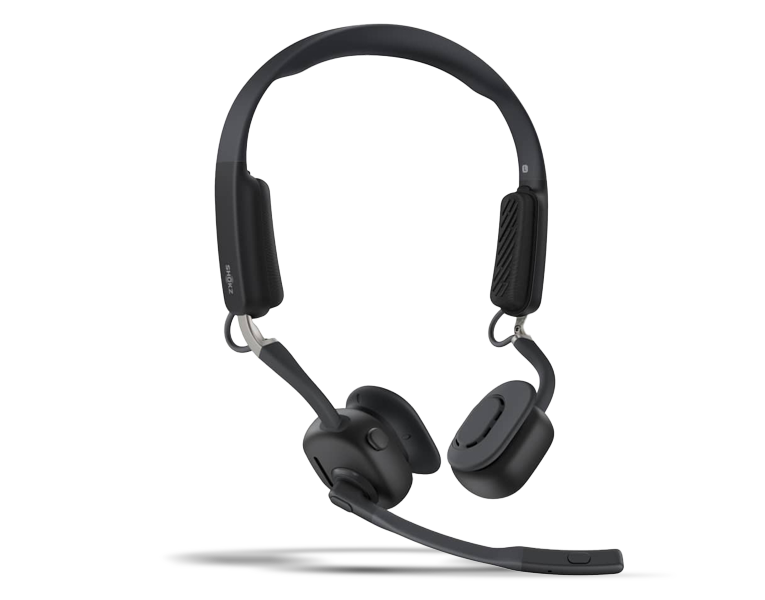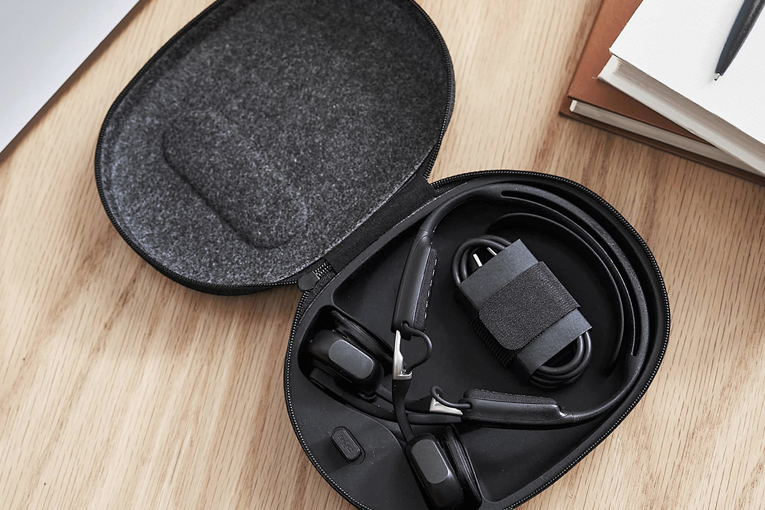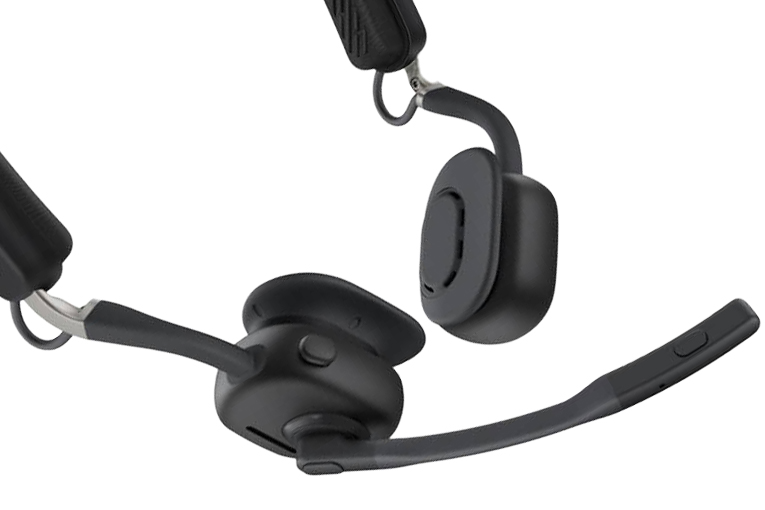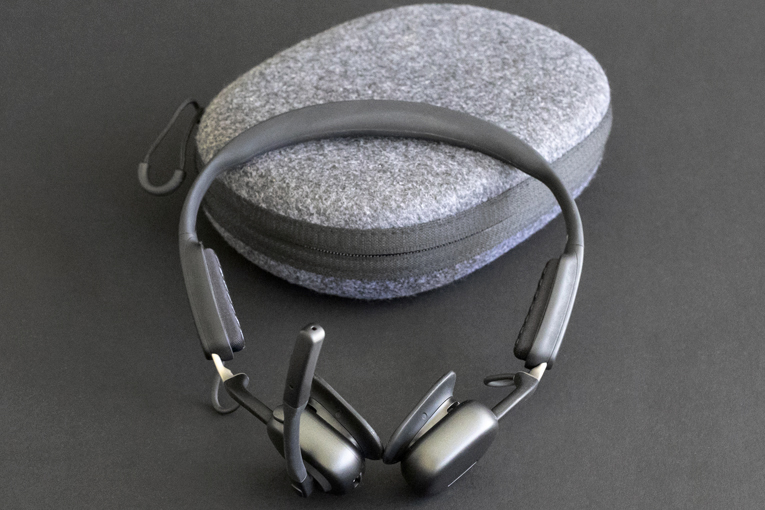Sound (music): 









Sound (voice): 









Value: 









(Read about our ratings)
The Shokz OpenMeet headset is a bit different from what we normally cover here at Solo, but no less interesting. Shokz, if you’re not familiar, is best known for bone-conduction workout and swim earphones. As you can see from the photos, that’s not what this headset is. The OpenMeet uses a combination of bone conduction and “air conduction,” aka traditional drivers, for a lightweight solution for people who spend long hours in Zoom meetings and on calls. Because it’s open, the earcups sit in front of your ears, so you can also hear the world around you. Since the headset doesn’t cover your ears at all, and in fact barely touches your head, your ears never get hot.

The OpenMeet has a rotatable boom mike, long battery life, and Bluetooth 5.4 so you can connect multiple devices at once. At $219.95 (all prices USD), it isn’t cheap, but for something you’d theoretically use all day long and not be annoyed wearing? Yeah, as I said, it’s interesting.
In the box
Included with the OpenMeet is a compact, cloth-textured hard case. There’s also a USB-C-to-USB-C cable for charging, and two additional temple pads, one sized medium, the other large. These work sort of the opposite of eartip sizing, in that the larger sizes are for people with smaller heads, so they can get a more secure fit.
Also included is a tiny USB-C adapter Shokz calls the Loop120. This instantly connects your non-Bluetooth computer to the OpenMeet. This can also be handy if your job has you rotating between computers, making it a hassle to connect and reconnect Bluetooth devices. Of course, that assumes your IT department hasn’t locked down the PC to reject anything connected via USB.
Use
The OpenMeet is extremely light, weighing just 78gm. For comparison, the lightest headphones I’ve reviewed recently were the Beats Solo 4 ($199.99) at a comparatively lead-like 217gm. As mentioned, the OpenMeet earcups don’t touch your ears at all. Instead, they press very lightly on your temples (or sideburns, if you’re so equipped). The clamping pressure is soft enough that if you do have sideburns or a beard, the headset can slip off if you tilt your head down to, say, look at your desk.

If you hold the earcups away from your head, you can just barely hear what’s playing. It’s wild compared to how loud they sound when they’re vibrating your skull. To play that loud, normal headphones would sound louder held at a similar distance from your head.
The microphone is at the end of a small boom on the right side. You can tilt this up and out of the way. An option to connect/attach this on the left side would be cool, but likely unnecessary for most people. The single button is also on the right, and it sticks out pretty far and points up and forward, making it extremely easy to find. It pauses music (for when your boss comes by) and powers the headset on and off when you’re starting your interminable workday or rage quitting at 2:30.
I wrote microphone, singular, but there are actually two. Aided by Qualcomm’s Clear Voice Capture noise reduction, Shokz claims it “isolates your voice and reduces background noise by 98.6%.” In my testing it isolated my voice well, and those I was talking to said my voice sounded clear. A button on the boom mutes the mike for when you want to swear at a client. Tilting the boom up does the same, as does throwing the headset at a coworker.

Battery life is a claimed 14 hours talking or 15 hours just listening, but you can get two hours of talk time after just five minutes of charging. At higher volumes you can feel a slight vibration with certain voices and frequencies, since the earpads are literally vibrating, but it’s minor. There’s an app with versions for Windows, macOS, iOS, and Android that lets you adjust some settings and choose between two EQ modes, which I’ll discuss in a moment.
Sound
The OpenMeet is not meant for critical music listening or for games. That’s not to say it can’t do those things—it’s just akin to asking me to run the 100m dash at the Olympics. Would I finish? Eventually, for sure, but that’s not my skillset.
With that caveat in mind, I did listen to music on the OpenMeet. There was a lot more bass than you’d expect for something so, well, open. With “Late Last Night” from Hans Theessink’s Call Me (16-bit/44.1kHz FLAC, Blue Groove / Qobuz), the tuba at the start extended quite deep, though it lacked the definition of a more music-focused headphone or headset. Kick drums were flat and compressed. There also wasn’t much high treble. They didn’t sound muffled, but there was definitely no airiness. The soundstage was reasonable, not super wide but definitely seeming to extend out from the earpads. The vocal range and other midrange sounds were far more prominent than usual, which, of course, is the point.

As far as voices go, the OpenMeet excelled. When I was listening to podcasts, audiobooks, and talking to the occasional human, the voices sounded very natural. The extra bass makes them sound sonorous but not boomy. With an audio version of Robert Caro’s The Power Broker (Random House Audio / Audible), narrator Robertson Dean’s dulcet, baritone voice was warm and as engaging as the content. With the 99% Invisible podcast’s (Ogg Vorbis, Radiotopia / Spotify) 12-part series covering The Power Broker (can you tell what my latest obsession is?), the voices of cohosts Roman Mars and Elliott Kalan were clear with just a touch more weight, compared to traditional headphones.
If the standard sound doesn’t cut it for you, the app also offers a Vocal Booster EQ mode. This strips away many frequencies that aren’t helpful for understanding voices. It adds a sort of cupped-hands effect, but it could help make voices clearer in certain situations.
Lastly, there’s an aspect that I think is highly valuable but perhaps not quite obvious. The part of the OpenMeet’s sound that’s perhaps its greatest strength is your own voice in your ears. Having a conversation using most headphones and earphones mutes your own voice in a way that’s unnatural. Some models will feed your voice back into the overall mix (called sidetone), but this feature is surprisingly rare. Earbuds like Bose’s Ultra Open ($299) and a few others also let the sound of your voice in naturally, as would a headset with just one earcup. Earbuds might have all-day battery life, but most don’t, and one-sided headsets had better be side-swappable, otherwise you’re going to fatigue one ear. Which is to say, talking to someone via the OpenMeet tends to feel more naturally conversational.
Conclusion
Don’t worry, Solo isn’t pivoting to review office headsets. Nor is this review a backdoor pilot for a SoundStage! Cubicle spinoff. The fact is, a lot of us still have to partake in the occasional Zoom meeting or call. Some have to do them regularly, and making them as comfortable as possible is a small but notable life improvement. Adding better audio for yourself and your interlocutors during the occasional parlay is a worthy goal.

I found the OpenMeet very comfortable. I never quite forgot it was there, but it was certainly easier to live with for long hours compared to many headphones. The OpenMeet’s exceptional lightness is one of its biggest advantages, as is the ability to hear your own voice while you’re talking. With music and games, the sound is better than you might expect from an office headset. Is all that worth over $200? It depends. How many hours a day will you be using it? If that answer is more than “a few,” the OpenMeet is definitely worth considering.
. . . Geoffrey Morrison
Associated Equipment
- Smartphone: Google Pixel 9 Pro
- PC: iBuyPower Windows 10
Shokz OpenMeet headset
Price: $219.95
Warranty: Two years
Shokz
3200 Gracie Kiltz Lane, Suite 300
Austin, TX 78758
Phone: (737) 215-4011
Website: shokz.com




